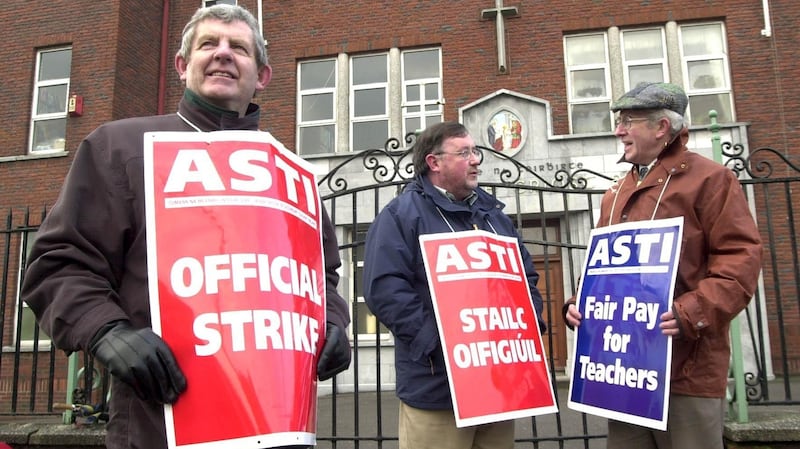The teachers’ conferences are on and there are loud demands for pay equality and higher spending – and a clear preparing of the ground for wider pay demands. One of the key issues raised has been the pay and conditions – and even the pensions – of younger teachers, hired after the crisis on lower pay rates. So are teachers really poorly paid and what are the implications of the calls for equality ?
1. The basics: Teachers, like all public servants, had their pay cut and other terms and conditions altered during the crisis. Under the terms of the Lansdowne Road agreement, public servants earning up to €70,000 – approximately 90 per cent of the total – will have their basic pay fully restored to pre-crisis levels by the end of next year, with higher earners not far behind.
There are twists to the story. A pension-related deduction introduced during the crisis has been turned into an additional pension or superannuation contribution (ACS), averaging 4 per cent to 6 per cent of gross salary for most teachers employed before 2013.
As with all other income tax payers , teachers will also have seen their purchasing power hit by higher taxes, with the USC being the main culprit. There was also some restructuring and in some cases reductions of special allowances paid to teachers and increases in hours.
As with most public servants, a notional teacher at a certain point of the pay scale –say with 10 or 15 years experience – will generally be back at 2008 levels by the end of next year.
However many individual teachers will have received annual increments – pay increases based on seniority – in the interim. So this group will be earning a bit more than they did when the crisis hit.
Around 31,800 of the 62,000 teachers employed received increments last year – significant numbers will already be at the top of the scale and thus not qualify. (ASTI members had their increments frozen in 2016-17 when they were in dispute with the Government). Annual increments to teachers cost the exchequer around €55 million per annum.
2. Younger teachers: There are specific issues for younger teachers taken on after January 2011, who were hired initially on a different pay scale obliging them to start at a lower point. Combined with cuts to allowances this left them at a significant disadvantage to their more established colleagues.
Some initial changes were made in a 2016 agreement to eliminate some of the disadvantages for new entrants.
Then a 2018 Government report estimated that 23,780 people in the education sector, of which just over 16,000 were school teachers were affected by this two-tier issues and that eliminating the two-point differential fully would cost €83 million. Across the entire public sector it would cost €200 million to address, the report said.
The starting pay for teachers is now €36,318, rising to €37,692 by next year. This compares to average starting pay of around €30,000 in the public service and a starting salary of around €29,000 generally.
Last year, a deal was done on the issue between the Government and the unions. Under its terms, new public servants, including teachers, would skip points 4 and 8 on the pay scale, meaning they would gradually move back into line with their colleagues. The phasing in spreads the cost for the exchequer – just under €200 million – up to 2026.
However the teachers’ union have pushed for more and argued that there is still a gap between younge entrants and more established colleagues, due to the operation of the pay scales and the changes in qualification rules for some valuable allowances.
The issues differ slightly in primary and secondary – for example, in primary teaching it generally applies to teachers recruited between 2011 and 2015, while at secondary level the non-payment of the hDip allowance of €1,236 each year to new entrants is an issue.
In a statement agreed before the teacher conferences, the Government said that it would give "due consideration" to these issues either in a special process or in the context of a new pay deal after 2020. Minister for Education Joe McHugh has said he recognises this is "unfinished business," but the Department of Public Expenditure and Reform is taking a more cautious approach, saying the only commitment is that the issue "may" be addressed.
Having cut a deal on this issue only last year – and saying that the issue was now dealt with from a Government point of view – it will be interesting to see where this goes.

3. Starting pay: Pay for teaching graduates compares well with others in the economy. A study by the Higher Education Authority found that teachers were the most likely group of college graduates to gain employment after their degree and that they were earning the most nine months after leaving college.
The starting pay for teachers is now €36,318, rising to €37,692 by next year. This compares to average starting pay of around €30,000 in the public service and a starting salary of around €29,000 generally.
The key cost-of-living issue for younger teachers is the same as for those in other sectors – the cost of housing in urban areas. This is now a source of upward pressure on wages across the economy.
4. Pensions: A key benefit to public sector employees compared to those in the private sector is pension entitlements. All public servants have defined benefit pensions, guaranteeing a pension related to salary – increasingly rare in the private sector due to the financial cost and risk to employers. During the crisis, a pension levy was introduced for public servants and this has been turned into an ongoing contribution.
For those employed before 2013 and on the old scheme – guaranteeing a pension related to final salary, a tax-free retirement lump sum and payments index linked against public sector wages – this contribution kicks in at earnings of €35,000 at a rate of 1 per cent, rising to 8 per cent for the highest earners.Teachers would generally pay 4 to 6 per cent (a net cost of 2 to 3 per cent).
Opening up a new front, the teachers' unions have now indicated they will push for better pension arrangements for those employed since 2013.
A Department of Public Expenditure and Reform study costed the pre-2013 pension at an employer cost of 29 per cent of salary, compared to around 11 per cent in a private sector scheme, a gap of 18 per cent. For post-2013 employees the gap was small compared to a comparable private sector scheme.
However defined benefit schemes are not generally available now in the private sector. The post-2013 group make lower contributions but have a pension based on average rather than final salary and increases based on consumer price inflation.
Opening up a new front, the teachers’ unions have now indicated they will push for better pension arrangements for those employed since 2013. The unions are calling for a review of the post-2013 scheme, arguing that this group is disadvantaged.
However given the huge cost of the original scheme and the outstanding pension liabilities it faces, the Government is likely to resist change here strongly.
5. International comparisons: The OECD compiles a host of statistics on the educational sector which allows international comparisons. Caution is needed in making comparisons due to differences in data and teaching practices.
The pay figures, adjusted to take account of the different costs of living in various countries, showed experienced Irish teachers (working for 15 years or more) at primary or second level at between 6th and 8th best paid of the 34 OECD countries surveyed in 2017, earning 25-30 per cent above the OECD average.
Reflecting in part the changes for new entrants, pay at entry level ranks lower, 4th out of the 32 countries at primary level and 13th at secondary, just above the OECD average.
The data indicates that teachers are paid relatively well here by international standards and teach slightly larger classes than the average. Teachers hours here also appear longer, particularly at primary level, though the Department of Education has warned that caution is needed in making comparisons here.
Figures for total spending on education are also hard to compare due to our distorted GDP figures, which show a low level of spending here around 3.5 per cent of GDP compared to a 5 per cent OECD average.
However adjusting for multinational distortion would bring Ireland more into line – and education spending here compared to total government spending is around the average.

Spending per pupil in cash terms is slightly below the OECD average, having fallen sharply during the crash. Total spending on education – as with other sectors – fell sharply during the recession, and allowing for higher numbers here in the meantime has not caught back up.
In contrast, spending per pupil generally across the OECD continues to rise, helped by the fact the elsewhere the school-going population has generally not been rising like ours.
6. The bigger picture: Education is a big spending sector and, together with health, accounts for €7 out of every €10 spent on public pay. So spending and particularly pay decisions in education matter for the overall public finances – and planning for the gradual decline in the school-going population during the 2020s, first at primary and then secondary level is a key challenge.
An official spending review published last summer showed current spending in education up by over €1 billion between 2014 and 2018, with the pay bill increasing by 19 per cent or €686 million, due in part to increasing teacher numbers and also the pay rises under the last two agreements.
Spending pressures will increase due to demographic factors. There will be savings as older teachers retire, but up to 2021 this will be outweighed by the combined cost of increments and new teachers.
Primary teachers are tabling demands for a pay hike for principals
This picture illustrates the challenge for the Government in planning for public service provision more generally, with a lot of extra spending happening almost automatically, as demand for services rise. The teachers conferences also point to other issues.
First, the deal with nurses has opened up demands for other concessions. Primary teachers are tabling demands for a pay hike for principals, for example, and the ASTI is looking for back-money for the period its members did not receive increments. And the issue of further moves for the post-2011 group will have implications elsewhere in the public sector.
Second, there is the next pay deal. The public sector unions are starting from the position that they have received “restoration”in the successive pay rises of the last few years – but that this does not represent a pay “increase”. Looking at rises of around 3.5 per cent in the private sector, the push will soon start ahead of talks next year.
And thirdly, the teachers’ unions have opened up the issue of the 2013 pension plan, even thought the Government faces massive liabilities in the years ahead from the old scheme, due to its hugely generous terms.
How this plays in the run up to an election – and with economic threats looming – will be fascinating to watch.











